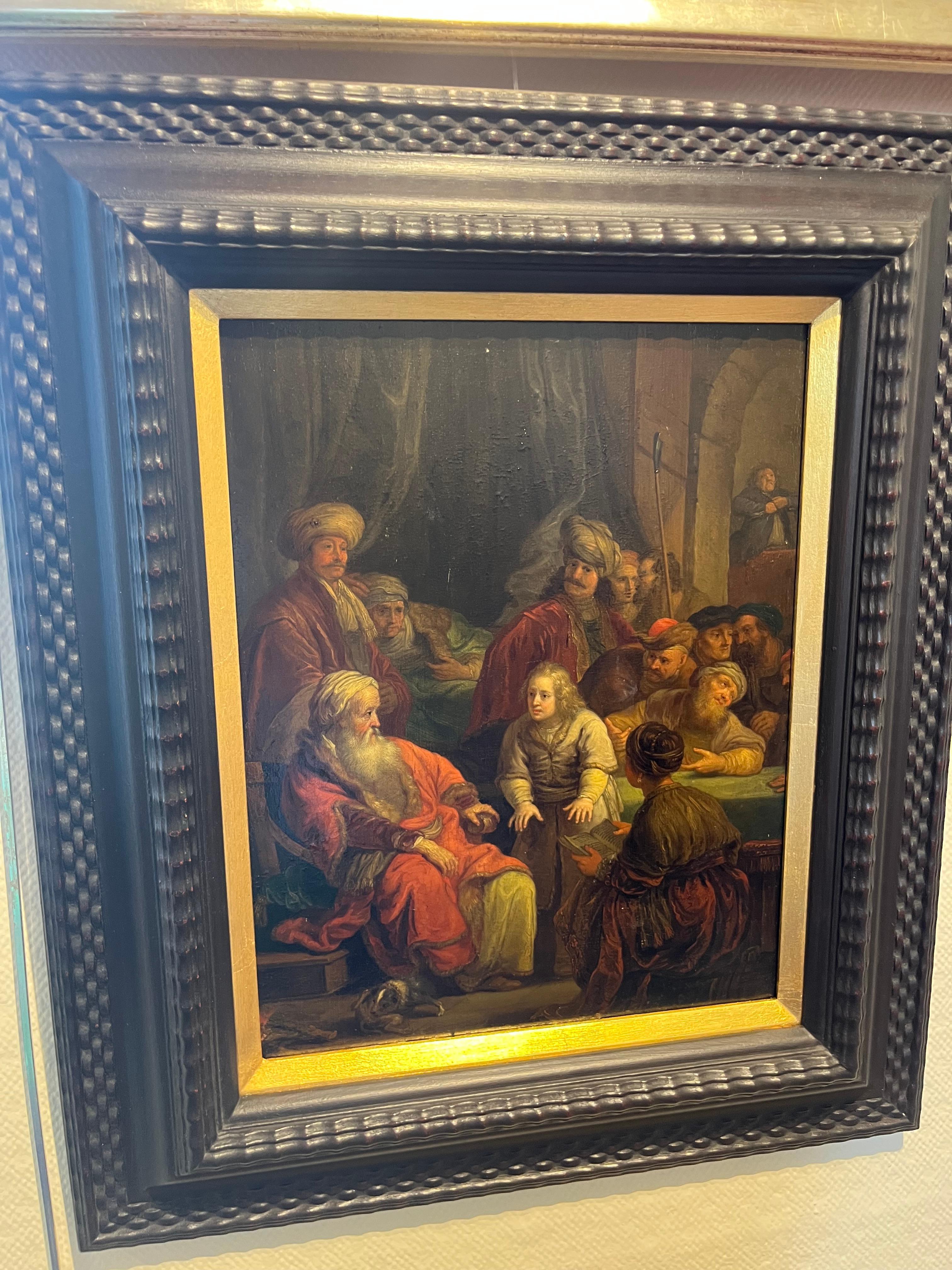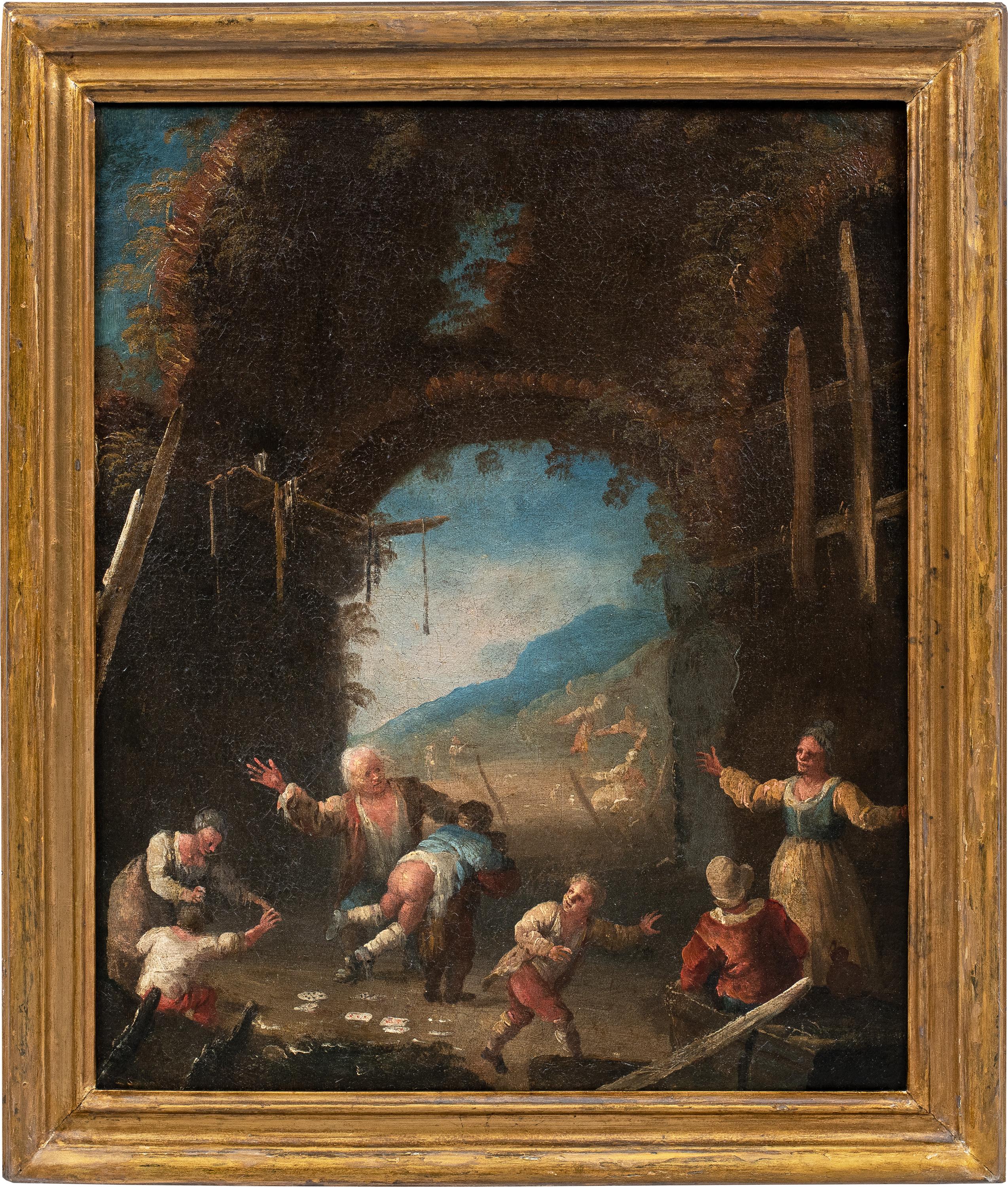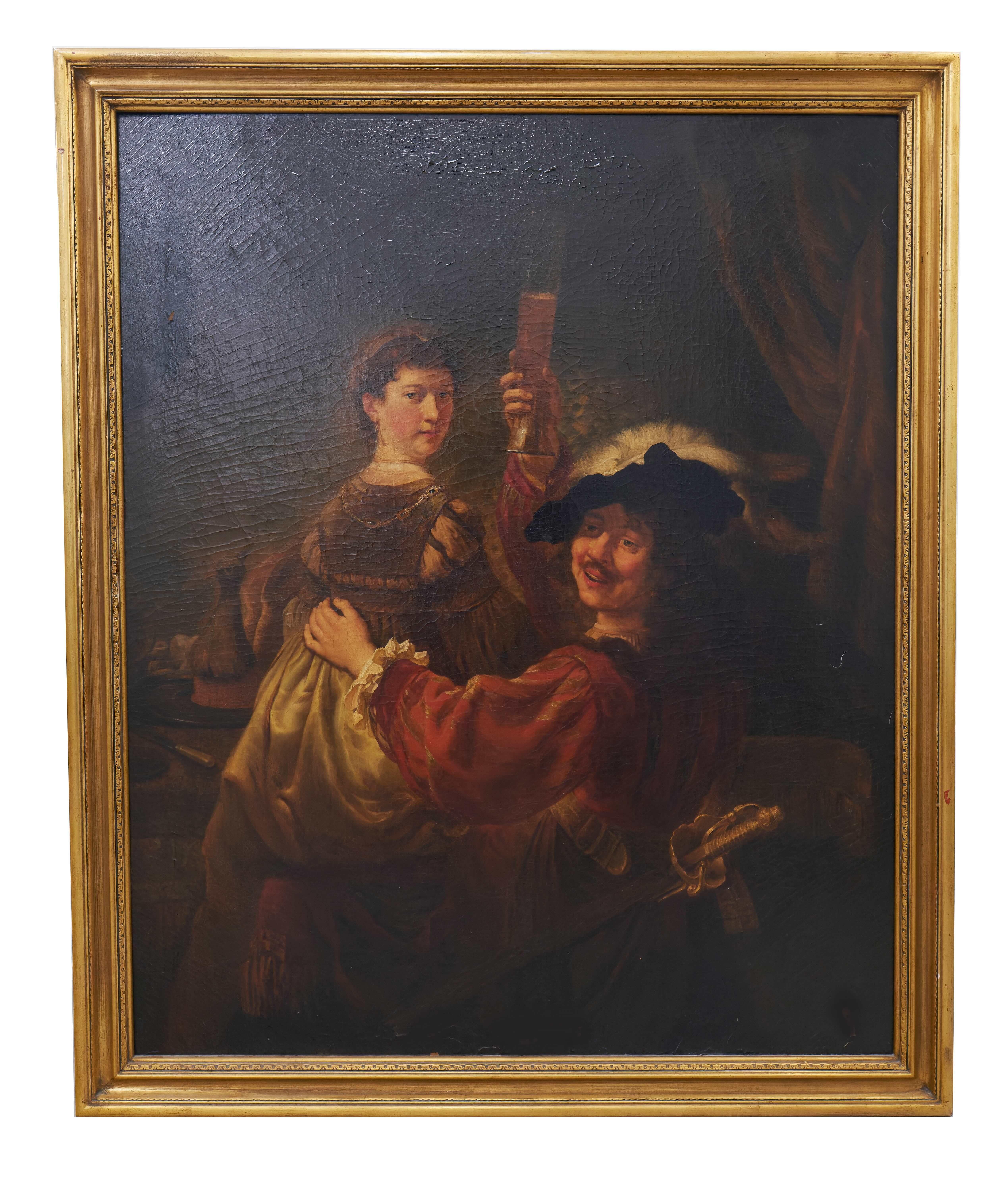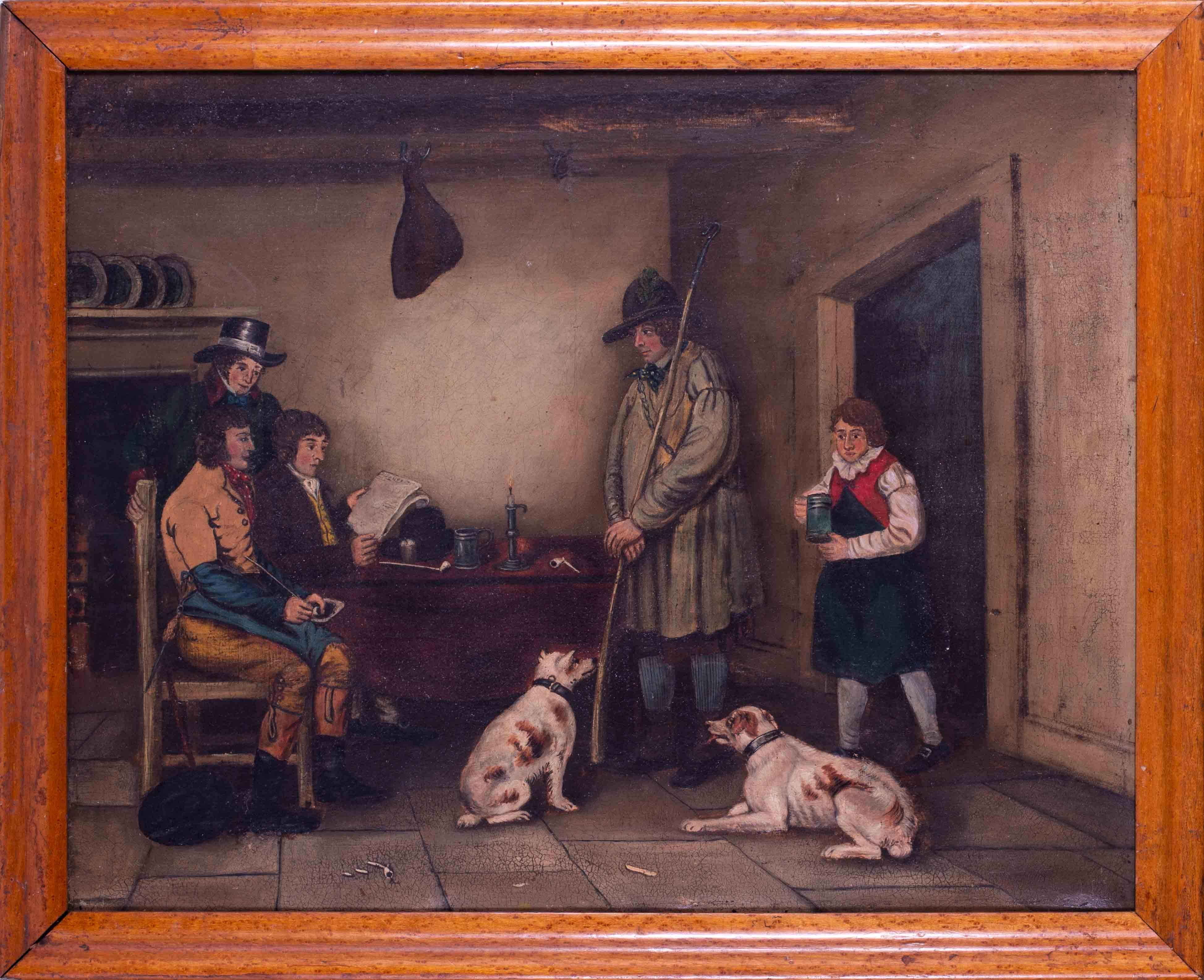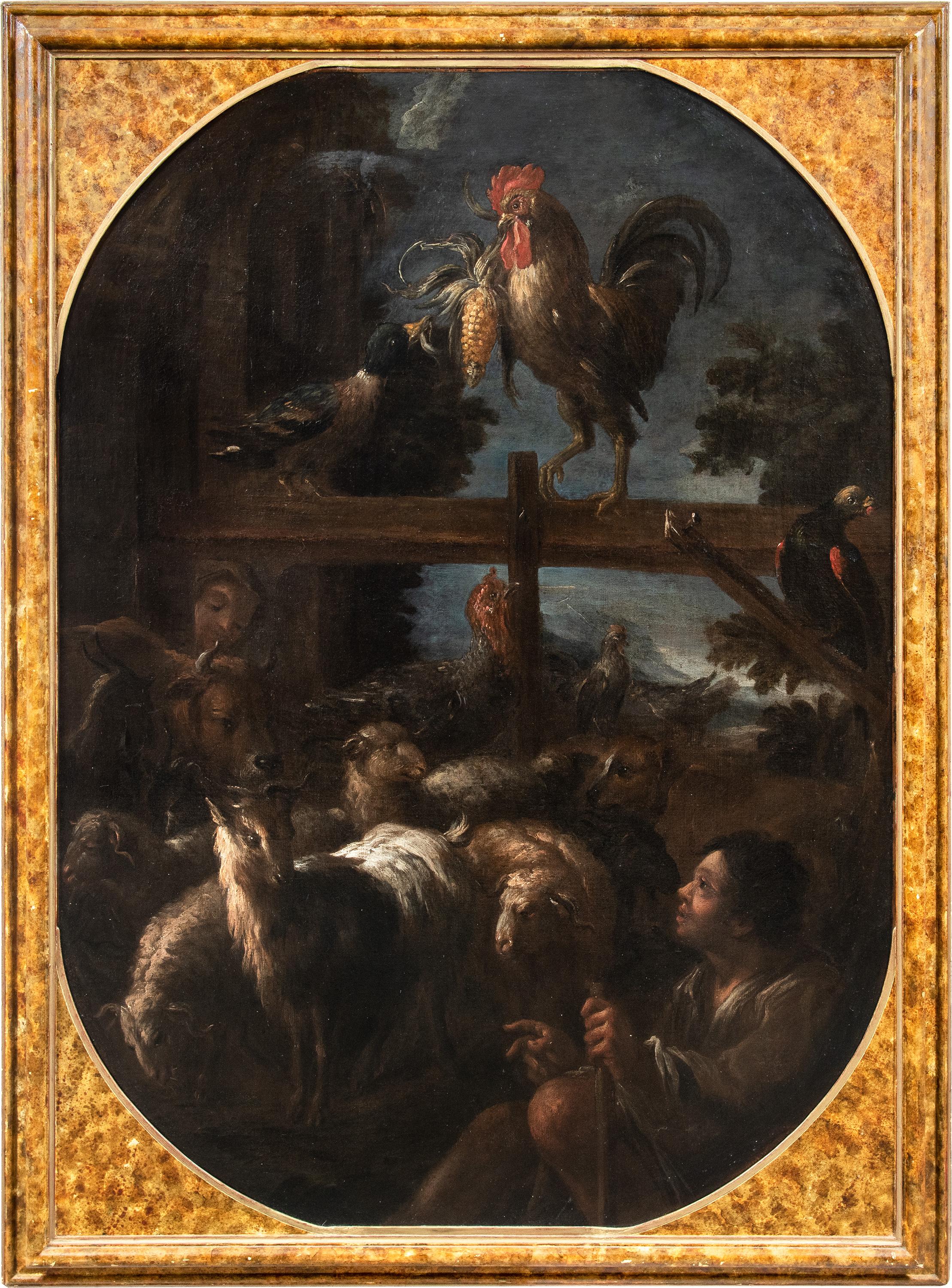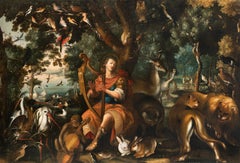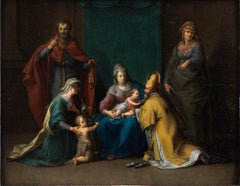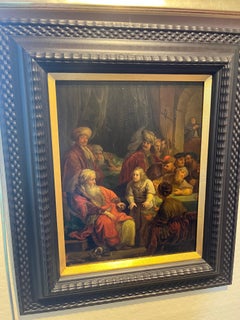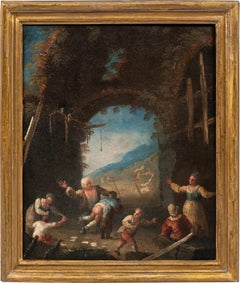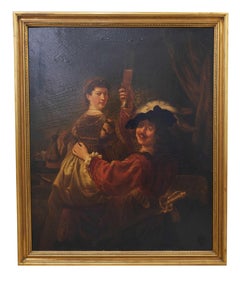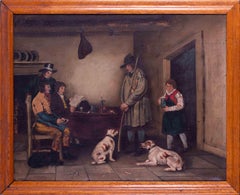Items Similar to Old Master Painting, Flemish Baroque, Religious Scene, Esau and Jacob, Lentil
Want more images or videos?
Request additional images or videos from the seller
1 of 18
Old Master Painting, Flemish Baroque, Religious Scene, Esau and Jacob, Lentilcirca 1650
circa 1650
$34,383.71
£25,660.36
€29,000
CA$48,006.47
A$52,359.38
CHF 27,528.43
MX$633,375.94
NOK 343,520.40
SEK 324,594.13
DKK 220,836.90
About the Item
Isaac and Rebecca had two sons: the twins Esau and Jacob. Esau was the first-born, giving him the birthright. Among Jews the birthright gave the eldest son authority over the family, and two parts of the inheritance.
One day Esau returns from the hunt, hungry. He asks Jacob for some of the lentil pottage that Jacob was eating. The soup (or stew) was red, just like Esau's hair. Jacob gives him the soup, but asks for the birthright in exchange. For Esau the right doesn't have much value, as he thinks he will die prematurely while hunting anyway. So he agrees.
The episode is the origin of the English expression "for a mess of pottage": giving away something that is important in the long term in exchange for short-term satisfaction.
The present painting is a work by the Circle of Erasmus Quellinus. The style is typical for Flemish Art of the mid of the 17th Century. Please note the fine details, e.g. the dog or the cock in the background.
- Creation Year:circa 1650
- Dimensions:Height: 19.77 in (50.2 cm)Width: 25.04 in (63.6 cm)
- Medium:
- Movement & Style:
- Circle Of:Erasmus Quellinus the Younger (1607 - 1678, Flemish)
- Period:
- Condition:
- Gallery Location:Greven, DE
- Reference Number:1stDibs: LU155028128902
About the Seller
4.8
Vetted Professional Seller
Every seller passes strict standards for authenticity and reliability
Established in 2011
1stDibs seller since 2021
30 sales on 1stDibs
Typical response time: 1 hour
- ShippingRetrieving quote...Shipping from: Greven, Germany
- Return Policy
Authenticity Guarantee
In the unlikely event there’s an issue with an item’s authenticity, contact us within 1 year for a full refund. DetailsMoney-Back Guarantee
If your item is not as described, is damaged in transit, or does not arrive, contact us within 7 days for a full refund. Details24-Hour Cancellation
You have a 24-hour grace period in which to reconsider your purchase, with no questions asked.Vetted Professional Sellers
Our world-class sellers must adhere to strict standards for service and quality, maintaining the integrity of our listings.Price-Match Guarantee
If you find that a seller listed the same item for a lower price elsewhere, we’ll match it.Trusted Global Delivery
Our best-in-class carrier network provides specialized shipping options worldwide, including custom delivery.More From This Seller
View AllVan der Bent, Southern Landscape with woman animals, Dutch Old Master, Berchem
Located in Greven, DE
17th Century Old Master, Figurative and Landscape Painting by Jan Van der Bent
So far, little is known about the life and work of Jan van der Bent. He was...
Category
17th Century Baroque Landscape Paintings
Materials
Canvas, Oil
$17,547 Sale Price
20% Off
Flemish 17th, Orpheus and Animals, Large Decorative Wall Old Master Painting
Located in Greven, DE
Flemish school, 17th century
Orpheus and the animals
Oil on canvas, 146,5 x 217 cm
Provenance: South German private collection.
On an impressive, room-filling format, this painting depicts "Orpheus and the Animals."
The harp-playing Orpheus sits centrally in front of a tree whose trunk bifurcates above his head. This central tree frames with its crown the scenery towards the horizon and at the same time offers through branches the possibility for many birds to find space. The left half of the picture is characterized by a seascape, at the edge of which the ruins of a castle can be seen deep in the background. This seascape, framed by mountains on the horizon, is the only area where sky can be seen. On this side, waterfowl such as storks, swans and ducks can be seen. In the right half, the viewer looks into a deep European forest. On this right side, more land animals can be found, such as deer, rabbits and lions, among others. Orpheus wears opulent red and gold trimmed clothing, under his blue breastplate we see a white shirt. His feet are adorned by elaborate sandals. His head is surrounded by a radiant laurel wreath ("poeta laureatus"). The young man is clearly identifiable as the singer and poet of Greek mythology, Orpheus, by his harp, the laurel wreath and the animals surrounding him.
Orpheus was one of the Argonauts who, under Jason, was searching for the Golden Fleece. He sang so beautifully that he even conquered the angry sea and enemies by the magic of his lyre. During the journey, Orpheus is said to have drowned out even the sirens with his singing. It is said that he was the greatest of all poets and charmed people, animals, stones and trees with his singing.
In total, 51 birds and 37 different species are depicted in the painting. The animals are mostly depicted in great detail and, except for a few, can be identified. Mainly European species of animals are shown. Exceptions are the ostrich-like nandu peeking out from behind the deer, as well as the large parrot on the upper left, and the two lions. Similar is the case for the large animal directly behind Orpheus on the right. The shape of the head suggests an arctic fox from the polar regions, even though the body is much too large. The arctic fox was first described in 1555 by Olaus Magnus. However, it could also be a depiction of a brown or black bear.
An unusual detail is the animal, which is relatively isolated in the right background and looks to the left. It is not clearly identifiable, but it shows certain similarities with the Australian kangaroo. This was first described by Vespucci in 1500 and further by Francisco Pelsaert in 1629. If it is indeed a kangaroo, this would be one of the earliest surviving pictorial representations.
In this painting, Orpheus is accompanied by a small monkey playing a viola da gamba. This is an iconographic peculiarity. In general, this painting has some peculiarities compared to other paintings with "Orpheus and the animals". The central positioning of Orpheus is quite common, but he usually holds a lyre and is dressed in an antique style, but not as opulently. The choice of animals is also remarkable: European animals in particular are seen, hardly any exotic features, such as camels or elephants.
The two lions in the right foreground are a quotation from Peter Paul Rubens and his depiction of "Daniel in the Lion's Den", which was realized in an engraving.
The present painting can be classified as belonging to the Flemish School of the 17th century on the basis of its painterly and compositional conception. From the circle of Jan Brueghel the Younger are numerous representations of this Orpheus - theme, which take it as an opportunity to show as many exotic animals. There are also echoes of Spanish painters such as Juan de Arellano...
Category
17th Century Baroque Landscape Paintings
Materials
Canvas, Oil
Hercules and Omphale, Old Master Painting, Mannerism, Baroque, Mythology, Prague
Located in Greven, DE
Hercules and Omphale
Oil on panel, 52 x 41 cm
According to legend, Hercules had to make atonement and became a slave to the Lydian queen Omphale. When she found out who her slave was, she married him. Falling for his mistress and made effeminate by the luxury of court life, the former hero allowed himself to become the laughing stock of the court. He dressed in women's clothes, spun wool and did other women's work, whereas Omphale wore his lion's skin and carried a wooden club. When the time of punishment was over, the hero realised his delusion and left Omphale.
So far, the painting could not be clearly assigned to an artist. Nevertheless, it impresses with its fluid and convincing painting, whose colourfulness and conception are reminiscent of the Prague School around Bartholomäus Spranger.
This work follows an engraving and an etching made by Michel Dorigny in 1643 after a design by Simon Vouet. It shows the same scene but the print differs in minor details from the present painting (see e.g. the head of the lion) and the treatment of the faces seems to be painted more detailed and refined.
So far there is no painting...
Category
17th Century Baroque Figurative Paintings
Materials
Oil, Panel
Sacra Conversazione, Maria, Christ, Old Master, Religious, Baroque Painting, art
Located in Greven, DE
Attributed to Peter Candid / Pieter de Witte
(Bruges c. 1540 - 1628 Munich)
Sacra Conversazione
Oil on wood, 29 x 37 cm
The painter, sculptor and architect Peter Candid, known in Italy as Pietro Candido, was born in Bruges between 1540 and 1548. In the 1560s he stayed in Florence, where he worked in the workshop of Giorgio Vasari, with whom he collaborated on a number of commissions for the House of Medici. After a brief stay in Volterra, he went to Munich in 1586. For the next 42 years, until his death, he remained court painter to Duke William V...
Category
17th Century Renaissance Figurative Paintings
Materials
Oil, Panel
Soldiers by a Tent, Soldiers Camp, Circle Van Huchtenburg, Old Master Painting
By Jan van Huchtenburg
Located in Greven, DE
Circle of Jan van Huchtenburg
Landscape Scene with a Soldiers Camp
Oil on Canvas, 41 x 55 cm
Soldier Camp Life Scene
together with a wonderful golden Frame
Category
18th Century Baroque Landscape Paintings
Materials
Canvas, Oil
$23,712 Sale Price
20% Off
Euklid Philosopher, Portrait of a Man, Old Master Painting, Baroque Art
Located in Greven, DE
Impressive Painting of the philosophy Euclid, painted in the Manner of Luca Giordano.
Provenance: Amsterdam, Sotheby's, 21.11.1995, Lot 46
Category
17th Century Baroque Figurative Paintings
Materials
Canvas, Oil
You May Also Like
Seventeenth Century Old Master Biblical Oil Painting Joseph recounts his Dream
By Rembrandt van Rijn
Located in ludlow, GB
Seventeenth Century Old Master Biblical themed Oil Painting on Panel of Joseph recounting his Dream. A Follower of Rembrandt Harmensz Van Rijn 1606 - 1669. This painting follows a ...
Category
17th Century Old Masters Figurative Paintings
Materials
Oil
Matteo dei Pitocchi (Baroque) - 17th century figure painting - Genre scene
Located in Varmo, IT
Matteo Ghidoni, known as Matteo dei Pitocchi (Florence 1626 - Padua 1700) - Genre scene with a scolded child.
67 x 55 cm unframed, 79 x 67 cm with frame.
Ancient oil painting on ca...
Category
Late 17th Century Baroque Figurative Paintings
Materials
Canvas, Oil
After Rembrandt "The Prodigal Son in the Tavern" Old Master Style Painting
Located in San Francisco, CA
After Rembrandt
"The Prodigal Son in the Tavern"
Old Master Style Painting
Late 19th century - Early 20th century
Oil on Canvas
36.75 x 44.5 unframed
40.5" x 48.5" framed
Category
Late 19th Century Dutch School Portrait Paintings
Materials
Canvas, Oil
Early 19th Century, English provincial school, 'Travellers at the inn
Located in Petworth, West Sussex
English Provincial School, early 19th Century
Travellers at an inn
Oil on canvas
17 x 21 in. (43.2 x 53.3 cm.)
Category
19th Century English School Figurative Paintings
Materials
Canvas, Oil
Knight Van Douw Paint Oil on canvas Old master 17/18th Century Flemish Art Italy
By Simon Johannes van Douw (Antwerp c. 1630 - c. 1677)
Located in Riva del Garda, IT
After Simon Johannes van Douw (Antwerp c. 1630 - c. 1677)
The stop of a traveler on horseback near a post station
Oil painting on canvas
45 x 55 cm
In frame cm. 55 x 65
In this pleasant painting, depicting a knight parked near a post station, the Flemish tradition is based on a strong Italianizing sensitivity, especially by observing the setting and its peculiar brightness.
The mixture of genres and the particular style of execution make it easy to trace the authorship back to a Nordic author but active in Rome, or strongly influenced by the style in vogue in the Eternal city, between the seventeenth and eighteenth centuries: we are referring, in in particular, to a follower of the Antwerp Simon Johannes van Douw.
The chromatic elegance and refinement with which he outlines the figures are typical aspects of his painting.
The scene takes place outside a cottage, probably a post office for travelers, where a modest family divides the tasks by assisting the knights. We see a young boy who hands water to the horse before he sets off again, the father is preparing to feed him with straw and the mother who instead takes care of the little son.
The Italian reminiscences, evident in our painting, have been absorbed by many Northern European authors such as Nicolaes Berchem, Philips Wouwerman or Johannes Lingelbach, all inspired by the leader Pieter van Laer...
Category
18th Century Old Masters Paintings
Materials
Oil
$4,192 Sale Price
20% Off
Felice Boselli (Baroque) - 18th century figure painting - Still life Sheperds
By Felice Boselli
Located in Varmo, IT
Felice Boselli (Piacenza 1650 - Parma 1732) - Shepherd with flock and game.
155 x 112 cm without frame, 170 x 126 cm with frame.
Ancient oil painting on canvas, in a wooden frame lacquered in faux marble. The painting has stylistic affinities with "Game with children playing with a dog" (Parma, Galleria Nazionale) and with the pair of paintings "Old man and girl...
Category
Early 18th Century Baroque Still-life Paintings
Materials
Canvas, Oil
More Ways To Browse
Flemish Baroque
Religious Oil Painting 17th Century
Antique Religious Oil Paintings
Flemish Panel
Antique Messer
17th Century Religious Paintings
Old Religious Painting
Old Masters Religious Paintings
Religious Art Panels
C Dawn Davis Paintings
C W Smith
Caravaggio Light
Carl Spitzweg
Carol Weight
Caroline Walker
Charles Baxter
Chris Stoffel
Christoffel Bisschop
